 advertisements advertisements
|

|
Bjarni Tryggvason, one of Canada's original astronauts, dies at 76
April 6, 2022 — Bjarni Tryggvason, one of Canada's original six astronauts who flew on board NASA's space shuttle, has died at the age of 76.
The news of Tryggvason's death on Monday (April 5) was first shared online by former NASA astronaut Leland Melvin, who trained with Tryggvason as a member of the U.S. space agency's 1998 group of international astronaut candidates.
"Rest In Peace Penguin classmate. It was an honor to train and work with you," Melvin wrote on Instagram on Wednesday (April 6). "Condolences to the family. Much love."
The Canadian Space Agency (CSA) subsequently confirmed that Tryggvason had died with a statement posted on Twitter.
"It is with profound sadness and heavy hearts that we learned that former CSA astronaut Bjarni Tryggvason has passed away," the agency wrote. "He applied the highest standard to everything he undertook."
Tryggvason's one and only spaceflight preceded his training with Melvin. Selected by the National Research Council of Canada to become one of the country's first six astronauts in 1983, Tryggvason launched as a payload specialist with NASA's STS-85 crew in August 1997.
The 12-day mission included the deployment and retrieval of a free-flying satellite (CRISTA-SPAS-2) that studied changes in Earth's atmosphere, as well as tested a predecessor to the remote manipulator system, or robotic arm, now outside the Japan Aerospace Exploration Agency's (JAXA) Kibo module on the International Space Station.
Tryggvason's primary task aboard space shuttle Discovery was to operate and evaluate the Microgravity Vibration Isolation Mount (MIM), a small, Canadian-developed instrument that was designed to isolate payloads and experiments from any disturbances caused by thruster firings or crew activity. An upgrade to a similar device installed and successfully used on the former Russian space station Mir, the MIM employed magnetic actuators to levitate and isolate individual experiments. It was later modified for use aboard the International Space Station.
On the seventh day of the flight, Mission Control woke Tryggvason and his five crewmates with the song "Good Vibrations" by The Beach Boys as a tribute to Tryggvason's work on the MIM.
"The fact that I was working on my own science experiments was really quite good," Tryggvason said in a 2015 interview with the Canadian news magazine Maclean's. "I decided to look at how fluids would behave in space. There are a lot experiments that have fluid as an element. I ended up developing this electromagnetic levitation platform [and] flew that on the Russian space station, flew that on my flight [and] was involved in designing another one that is up on the space station now."
Landing near where he launched at NASA's Kennedy Space Center in Florida, Tryggvason logged a total of 11 days, 20 hours, 28 minutes and 7 seconds in flight while completing 185 orbits of Earth.
Bjarni Valdimar Tryggvason was born on Sept. 21, 1945, in Reykjavik, Iceland, but spent his youth in Nova Scotia and British Columbia in Canada. He earned his Bachelor of Applied Science degree in engineering physics from the University of British Columbia in 1972, and later completed postgraduate work in engineering with a specialization in applied mathematics and fluid dynamics at the University of Western Ontario.
An airline transport-rated pilot with more than 4,500 hours of flight experience, including 1,800 hours as a flight instructor, Tryggvason was active in aerobatic flight and completed a captaincy check in a jet trainer with the Canadian Air Force. Prior to being an astronaut, Tryggvason worked as a meteorologist with the cloud physics group at the Meteorlogic Service Canada and as a research associate in industrial aerodynamics at the Boundary Layer Wind Tunnel Laboratory at the University of Western Ontario.
He was a guest research associate at Kyoto University in Kyoto, Japan, in 1979 and at James Cook University of North Queensland in Townsville, Australia in 1980. He was then a lecturer in applied mathematics at the University of Western Ontario from 1980 to 1982.
Tryggvason was serving a research officer at the Low Speed Aerodynamics Laboratory at the National Research Council of Canada when the council chose him alongside Roberta Bondar, Marc Garneau, Steve MacLean, Ken Money and Robert Thirsk as the members of its first astronaut corps.
Before lifting off on his own mission, Tryggvason trained as a backup for space shuttle Columbia's STS-52 crew and served as the project engineer for the Space Vision System Target Spacecraft that was deployed from that mission in 1992.
A year after he returned from space, Tryggvason joined "The Penguins," NASA's 18th class of astronaut candidates selected in 1998. The two years of basic training was to prepare Tryggvason for a possible flight as a mission specialist and initially he was assigned as a crew representative to SAIL, or the Shuttle Avionics Integration Laboratory, at Johnson Space Center, which was used to check out the flight software for each mission.
Rather than pursue another spaceflight assignment, though, Tryggvason took leave of the Canadian Space Agency (CSA) to work in the private sector. He returned to the CSA for another four years in before retiring in 2008 and went on to become a visiting professor at the University of Western Ontario.
A member of the Canadian Aeronautics and Space Institute, Tryggvason was awarded an honorary doctorate of science from the University of Western Ontario in 1998, an honorary doctorate of technology from the University of Iceland in 2000 and honorary doctorate of engineering from the University of Victoria in 2005. He was bestowed with the NASA Space Flight Medal for his launch in 1997, the Innovators Award of the Canadian Space Agency in 2004 and the Knight's Cross of the Icelandic Order of the Falcon.
In 2003, Tryggvason and seven of his fellow Canadian astronauts were honored by the Canada Post with postage stamps bearing their portraits.
"Lost a good friend today," fellow Canadian astronaut Chris Hadfield wrote on Twitter. "Pioneer astronaut, engineer's engineer, proud parent, inventor, test pilot. A kind, funny, original man."
In February 2009, Tryggvason piloted a replica of Alexander Graham Bell's Silver Dart aircraft to commemorate the centennial of the first flight in Canada and the British Empire.
More recently, Tryggvason designed the science demonstrations to accompany the "Story Time from Space" educational payload aboard the International Space Station and served as a technical advisor for the Roland Emmerich feature film "Moonfall," which was released earlier this year. He authored 50 published papers and held three patents.
Tryggvason is survived by his two adult children, Michael Kristjan and Lauren Stephanie Chironne. He was previously married to Lilyanna Zmijak, but the couple divorced. |
|
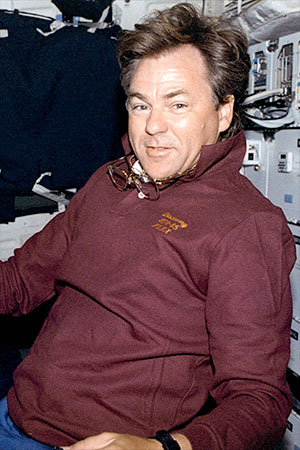
Canadian astronaut Bjarni Tryggvason, STS-85 payload specialist, shows off the Microgravity Vibration Isolation Mount (MIM) fluid disk on board the mid-deck of space shuttle Discovery in 1997. (NASA)
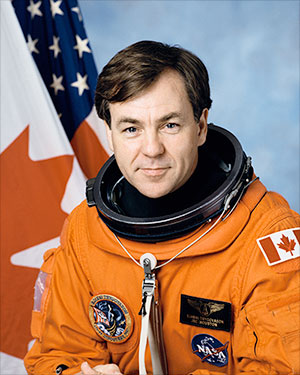
Official portrait of Canadian astronaut Bjarni Tryggvason. (NASA)
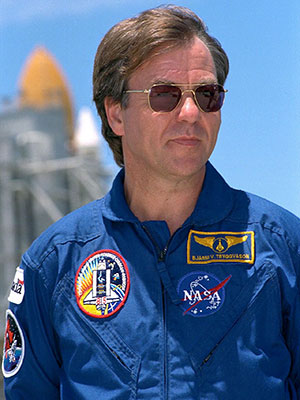
STS-85 payload specialist Bjarni Tryggvason is backdropped by the space shuttle Discovery on the launchpad in July 1997. (NASA)
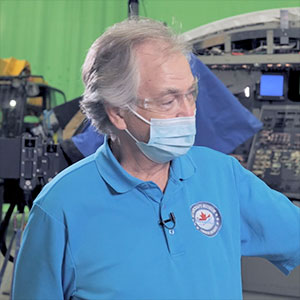
Former Canadian astronaut Bjarni Tryggvason is seen with NASA's retired Guidance and Navigation Simulator (GNS) on the set of the 2022 movie "Moonfall" by director Roland Emmerich. (Lionsgate) |
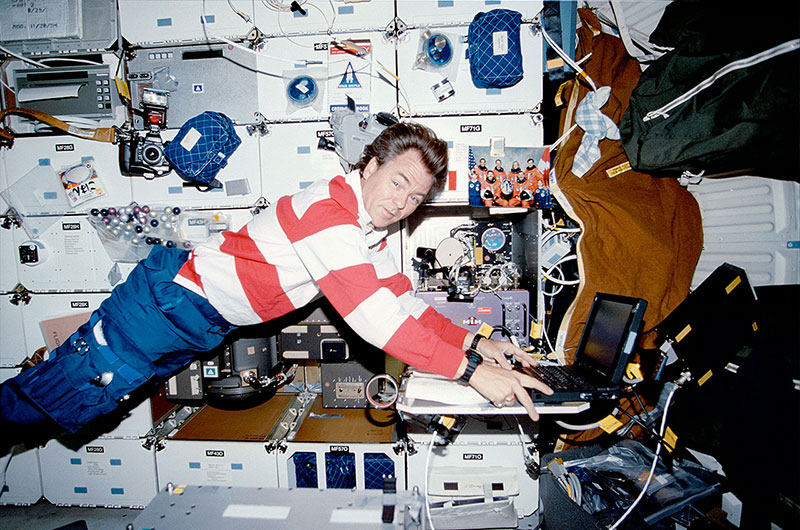
STS-85 payload specialist Bjarni Tryggvason, representing the Canadian Space Agency, records data from the Microgravity Vibration Isolation Mount (MIM) experiment on the mid-deck of the space shuttle Discovery in August 1997. (NASA) |
|

© collectSPACE. All rights reserved.
|
|

|

|
